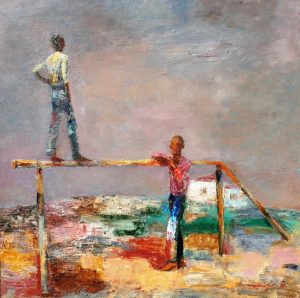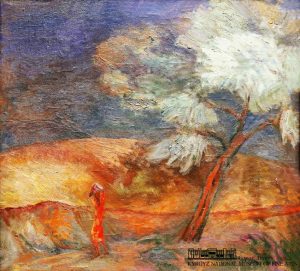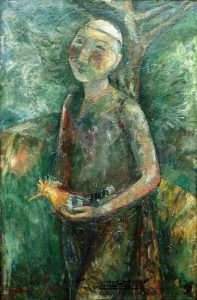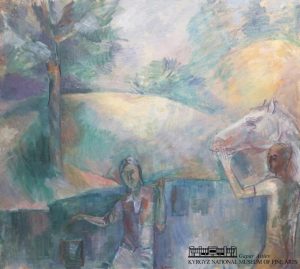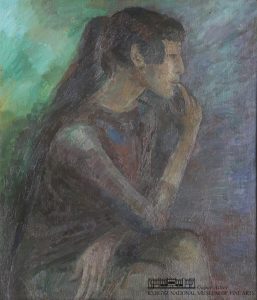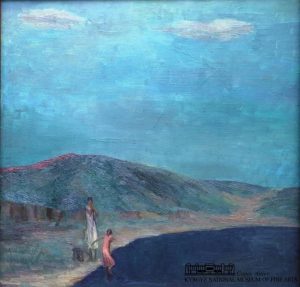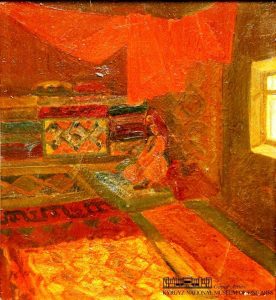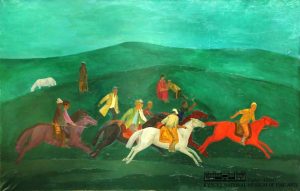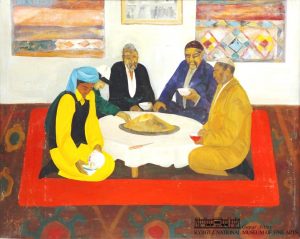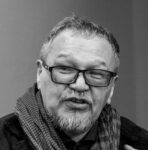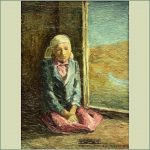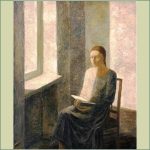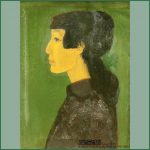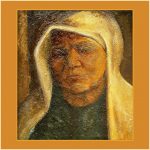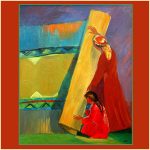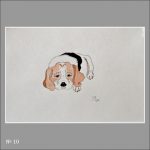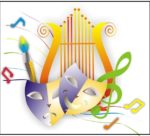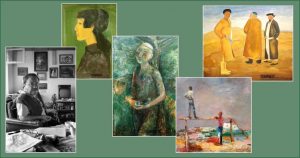
We continue our review of the work of Jambul Jumabaev through the eyes of art critic Gamal Bokonbaev. The second part presents 14 more works by the artist.
Jambul Jumabaev (1946-2005) – painter and drafter, book illustrator and production designer for feature and television films. His works are in the G. Aitiev State Fine arts museum, the Tretyakov Gallery, the State Museum of the East in Moscow, the museums of Saratov, Novosibirsk, Astrakhan, as well as in private collections in Japan, Germany, USA, Greece, Italy, etc.
School in the mountains. 1979. Oil on canvas, 100×100
Near the school, two teenagers are walking on the playground. In the distance, a one-story rural school building looms white. It is specially integrated into the design of the sports equipment. This is symbolic! The stand divides the school in half, into two shades, two moods: warm and cold, shadow and light, plus and minus. The roof slope is a descent from a log. Two windows and two figures. This is the state when classes are over, and there is time to be ourselves, to be sad about the past summer in the warm autumn twilight. Tomorrow again classes, lessons, grades, teachers and classmates, parents and diaries. In addition, refined figures are symbols. Alone on the crossbar, floating in the sky and talking to the clouds. The other one has grown into the ground, leaned against the crossbar, and thoughts overwhelmed him. One philosopher is another salesman; it will be easy for one, not so much for the other. However, boyish friendship lasts a lifetime. Where does the charm of the painting come from? From the understandable: composition, color, style, techniques, and from something else that cannot be expressed in words. Yes! Composition! If it were not for working with texture, the composition would seem… rustic. Texture is the language of Kyrgyz modernism. This is something that does not obey the logic of realism and follows only the logic of artistic flair. Texture is sharpness and blurriness, highlighting the important and dissolving boundaries. Of course, the shades and tone make the cloud, but it is the texture that makes it perfect! Yes! You cannot see the mountains at all. Is this a symbol? What? Are they all in a fog? Schoolchildren and school high in the mountains! On Olympus! On Fuji! When the earth is heavy under your feet and the sky is towering above your head, there is still time to understand: who are we? Who are we in ourselves? Soviet Kyrgyzstan late 70s, early 80s. Literature took place, a Kyrgyz miracle happened! In cinema, in theater, in architecture! What is next? …. While there is nostalgia for those times when it has already happened and is yet to come! The future is unclear and therefore exciting! Interesting! Amazing symbol!
Winter Senezh. Canvas, cardboard, oil, 68×50, 1979
In June 1945, by decision of the Presidium of the USSR Art Fund, the House of Creativity and Recreation of the same name was founded in the Solnechnogorsk district of the Moscow region on the shore of Lake Senezh. Artists came from all over the Union, rested and worked on full board. The race lasted two months, 70 people were accommodated at the same time, and up to five races took place per year. The commission selected the best works for the All-Union exhibitions. The Senezh design studio, an educational and experimental studio of the Union of Artists of the USSR, created in 1964 under the leadership of Evgeny Rosenblum and Karl Kantor, became famous here. The studio played a huge role in the development of Soviet design theory and practice, contributed to the emergence of a compositional approach in easel painting…
We have before us a magnificent composition: the author reveals the logic of appearance. A flat horizontal snow-covered field, behind which one-story wooden houses can be seen. They are in a low place and seem to have been cut off in half, and the foundation of a brick building has been cut off. Then there is a descent, but it is not visible, and a lake, which is also not visible. You can see forested hills rising on the other side. The relief of the lakeside area formed this unusual composition, and not the arbitrariness of the artist! In addition, the artist was able to see the advantages of not the most interesting vantage point. This suggests that the author is a highly original person. He is not interested in effects, lakes and open spaces; he is only interested in what can be seen with his mind. In addition, what is not visible awakens the imagination! Bold composition! The line of the field echoes the line of the roofs. The first autumn snow is whitening in the sun, the distant forests are also illuminated, but they have already darkened. The view from the village, it can be seen on the map. It has a name – Zagorye. Moreover, in the village, there is a rural shop, to which an artistic path has been trodden…
Evening in the south. Oil on canvas, 94×100, 1978-1980
Evening, or rather, twilight in the south. The sun has heated up the earth and has just set below the horizon. The coloring still holds the heat and the figures radiate warmth. In addition, it is already cool in the green sky. It is still light at this late hour. Two girls are finishing work in the field. One holds a huge bale of cotton on her head; the other bent down and bandaged the burden. There is a lot here from Zinaida Serebryakova (“Whitening the Canvas”, studies and sketches of 1917). Poses and moods, lightness and clothing. For Serebryakova, everything is justified by the work process, but here it is not clear why? Finishing work? Jean Millet comes to mind. Achievements of world painting they help the Soviet artist glorify the work of young collective farmers. Therefore, both the theme and the plot are just a cover. In Soviet Kyrgyzstan, the topic could not be different, and the plot could not be different. They are not the main ones and exist only to be able to talk about something else. About the fact that texture, color, composition can be strange! The texture alone (clouds, earth, and clothes) can tell about the birth of a pattern, the smell of everyday life, the power of tradition and the desire for something new! About orange passion in brown suffering… However, will all this content be understandable now? In another country? In addition, do we need it? Will we not get confused in the intricacies of the Soviet bird language?
Heat. Oil on canvas, 60×65, 1977-1979
A woman in a red dress is walking along a path made by people from the edge of a steep hill. He carries a burden on his head and uses it to protect himself from the sun. The road is not visible – the line of dissection of the volume is visible. A blue elm grows along the line. That is all. Hill and path, woman and tree. Yes! In addition, a heat spares no one. Then there is the sky, which sets off the heat coming from the orange earth. However, the sky is not cool – it is just purple. The shadow from the crown does not help, and the woman is in a hurry to run errands. The trunk tilted to the right and glowed red, the red dress excites dances and glows. The color is the confusion of a running woman and the suffering of a motionless elm. The color of heat emanates from the painting. However, this is not impressionism, is it? Not written from life. Moreover, you will not see this in the open air. There are no such combinations in nature. An Artist composed them! They appeared out of nowhere, right on the canvas. I had a feeling that this is how it should be done. A painting is not realism. Moreover, not literature. A painting is materiality, substantiality, evidence of colors. Moreover, the spirit of the South, modern authentic. There is confidence that what was done on a whim is more like the truth. Where does the confidence come from? I read, worked, thought. In addition, from above, from time to time, which you do not understand, you just hope that everything will be fine. Moreover, the next step will be difficult to take. Soviet inability to take the next step…
Boy with a hoopoe. Oil on canvas, 87×59, 1975-1976
A boy stands under a tree and holds in his hands a brightly colored bird with a long narrow beak and a crest opened in the shape of a fan. Hills are marked in semicircles behind. The tree has bent over and is moving upward. Everything is summarized and resolved in a single gray-green color. Except for the hoopoe! The hoopoe is the center of color, drawn with care and detail. The paradox is that in this couple, the boy is a hoopoe, the young naturalist merges with nature, and the wild bird stands out. The boy is more like a doll, and the hoopoe is more like a soul, alive and tense. The boy is the form; the hoopoe is the content… For some reason, I remember the half-forgotten TV movie “Road to Paris” (1968, directed by Alexei Studzinsky). There is a tomboy dragging around a dead duck. Of course, this is a completely different movie. Later, the symbol, a hoopoe boy, will be used in the film “Beshkempir” (1998, directed by Aktan Abdykalykov). There, the main character admires the bird and becomes inspired by it. In the future, a successful combination will become a template element of salon work. It will be noted that the hoopoe is often mentioned in world mythology. The hoopoe was chosen as Israel’s national bird in 2008. Then, in the mid-70s, the image was created! It appeared out of a desire to oppose something to Soviet unification. The result is an acceptable picturesque version: national in the all-Union. In addition, besides, a sacrament happened! What was drawn transformed life and became part of our spiritual world, that is, what we call art.
Spring. Oil on canvas, 90×100, 1975
The famous art critic Olga Popova writes about this and other similar paintings by the master, the following: “In these works, he (Dzhambul Dzhumabaev) abandoned the clear silhouette and locality of color, creating, for one reason or another, a color-painting, free from real lighting and the general state of nature a fantasy that easily models lyrical images.” That is it, it is easy. Exactly! The author too easily, without bothering, modeled the romantic image of meeting, youth, spring, the beginning of love! What talent! How skillfully he sketched the landscape. How he conveyed with light transparent colors the state of nature when spring mornings are still cool. A girl with a yoke, and a guy in a T-shirt (maybe a city guy?) brought a horse to a watering hole. They both dissolved in this transparent extravaganza of colors and feelings! That is why they are shifted to the right? The guy with the horse is advancing? Moreover, on the left, its pressure is balanced by a tree! These are our Aksinya and Grigory, a variation on the themes of “The Quiet Don”*. And what? Could this not happen in Kyrgyzstan? It could. In addition, there could be a river. Valley, not mountain. Not Don, of course, but it could have been. The composition turned out well, but I do not see any point in it! Olga Popova put it more mildly: the work was created “for one reason or another.” It seems that the artist followed his whim. This is not how you work on an easel painting. This is how they work… on an illustration. There is a literary basis; there is a plot, moods, ideas, form. The author is full of literature. He loves movies too much. He is part of the Soviet School and easily uses common achievements and… common templates. In addition, he does not see anything wrong with it.
*Aksinya and Grigory are the heroes of M. Sholokhov’s epic novel “Quiet Don”, an epic novel in four volumes. Mikhail Sholokhov (1905-1984) received the Nobel Prize in 1965 for this novel.
Portrait of a wife. Oil on canvas, 69.5×49.5, 1975
An inclined line divides the background into light and dark parts. The artist tilted the corner of the room using a third vanishing point, the so-called ceiling perspective. This is what the Cubists often did, pushing space upward. On the dark part of the background, at the table, the wife sat. A familiar profile, pink ribbon, thin brushes, one touched a lemon. There are two more apples nearby. A very complex decorative color: shades of green, blue, yellow, light purple, dark gray. Another portrait of the artist’s wife was painted three years after the first. Written in the style of Soviet Cézanneism – brutal** surroundings and a smoothed face. In such a picturesque interpretation, the “olive” face becomes like a beautiful mask. This is how the Soviet thing turned out to be more complicated than the existence*** of alienation and lack of communication. There are subtle layers here: patriarchal, Soviet, liberal. Here, and Egyptian spreads, and a profile of the Silver Age; and cubist space, and postmodern collage. Cannot figure it out – the quotes are too complex. It is better to wear a mask. Alternatively, perhaps the artist did not want to go to the end! I did not want to analyze my loved one. This is unsafe, and you can end up in formalism. Until now, when only form matters. Then: the profile, the pink ribbon, the lemon, and the thin hands – all this eventually turns into a manner.
Portrait. Oil on canvas, 70×59, 1974
The portrait of the artist’s wife is simply titled “Portrait”. The author is not interested in a specific person – he wants to understand the typical. This female type appeared in the art of the USSR immediately after the Thaw. In addition, everyone started talking about a phenomenon that is complex, ambiguous, doubtful and free in their doubts! This is Lelya – Tatyana Lavrova (Nine Days of One Year. 1962, director Mikhail Romm); Tanya – Margarita Terekhova (Hello, it’s me! 1965, Frunze Dovlatyan); flight attendant Natasha Alexandrova – Tatyana Doronina (Once again about love. 1968, Georgy Natanson). Unfortunately, the cinema of our Republic has not reached such frankness and ambiguity. There was a lot of feigned seriousness, pathetic relevance beyond the bounds, but there was no modern, urban, emancipated, eccentric and pretty female image. In addition, no. However, such an image appeared in Kyrgyz painting. The image is not so bright, not so articulate. Plastic, many-sided. Moreover, the composition is made in such a way that the character finds himself in the area of “half-light and half-darkness,” in the area of half-meanings. The light is green-blue from behind, it is bright and interesting, and everything is clear. There is company there, and no one doubts anything. In addition, the woman retired. She sits cross-legged and crosses her arms. Dressed simply and stylishly. Before her is a lilac-violet future, but, most likely, nothing. He looks into nothingness and rubs his lips with his finger. I thought a lot and was no longer so serene. Tension is transmitted by folds of clothing. In addition, the hands – not anatomy, not a drawing, but some vague broken signs. Doubts are inevitable and kill harmony. Next, something like a Soviet existence should have appeared under Michelangelo Antonioni with Monica Vitti. However, it did not appear, and could not appear in USSR cinema. What about painting? In our painting? Unfortunately, no either… In general, the Soviet artist of the 70s never understood the portrait of the artist’s wife.
Girls by the lake. Oil on canvas, 59×59.5, 1973
As Soviet art critics liked to say, this is a programmatic work for the author. However, what is her manifesto? With it begins the second stage in the artist’s work. The artist understood how he would paint, and most importantly, he understood what he was talking about. There are still realistic traditions and Soviet lyrics. The hills are material, the sky is airy, the water… opaque. The theme of youth, of course, Komsomol! In addition, there was no other one. True, the lake is something too mysterious and the sensations are strange. The girls came to the lake at dusk for water with buckets and a rocker. Not a single tree around. Strange. Could this be a new reservoir? Komsomolskoe? One is in a white dress; the other is in a pink one. We have already taken a swim. One braids her hair, the other rinses her feet. They are not afraid of being seen. Did you get water right away? Maybe it is from a spring. In this case, it does not matter. Young maidens are allowed everything! Moreover, the artist felt satori*! It happens when a view from afar, usually silent, stops time. Life flows somewhere in another dimension, you do not understand what is happening, but you agree with everything in advance. Because everything comes from above and there are no contradictions, contrasts, or struggle of opposites. There is no dialectics and metaphysics. There is simply life. In addition, it embraces a special peace. Any movement, random sound, and the enlightenment of the soul ends… Remains in painting! That is why we love her! The moment has stopped, and it is beautiful! Aitiev is extreme, Asrankulov is brutal, and Dzhumabaev is existential!
*Satori (Japanese – “enlightenment”) – in the meditative practice of Zen – the internal personal experience of the experience of comprehending true nature through achieving a “state of one thought”
Portrait of a wife. Oil on canvas, 32×24, 1972
The profile is an advantageous angle, laconic and mysterious. A reference to Nefertiti. A specific face, but facial features are symbols. The portrait of the artist’s wife is also a symbol. Moreover, it should inspire! The artist knows the model well, every feature. Complex things are said simply and much becomes clear. It is said in one line, in a local color, and the image lives on its own, without any angles or references. Green creates depth; it is comfort and evening relaxation. Black is passion within the boundaries of style. Ocher – moderation. A long neck is a virtue. Posture is calm. Raised eyebrows are polite. The hairstyle is unique and suits only her. She does not chase fashion. All together – a thing in itself! For an artist, even the closest person is a “thing in itself,” a model, interesting for the possibility of various interpretations. A character from a unique environment – the freedom-loving intelligentsia of Soviet Kyrgyzstan in the 70s. So recognizable and… limited, separated from the world by history. Voluntary exile, glorified curtain. There is no need to overstep boundaries, and so much is allowed. Everything should be within the bounds of decency and good manners. Freedom? Please, but no vulgarities, please. Thank you, and no radicalism, please… The artist managed to breathe something concrete into the symbol. The portrait seems to glow and illuminate all of us with a past, quiet, inner light.
Bride. Oil on canvas, 58×54, 1972
Perhaps it is in the bride’s house. To see the bride, the groom’s family must pay a ransom. Alternatively, perhaps it is already in the groom’s house. The bride is hidden in the far part of the room, blocked by a curtain. Now it is reclined. However, the white scarf is not visible. According to tradition, the mother-in-law must put a white scarf on the bride’s head. The artist saw, congratulated, blessed, bestowed, wished love, children, health, many years of family life… and depicted it. By memory. He is not interested in the subtleties of the ritual – the artist is interested in a light rectangle, an open curtain and, of course, the bride. You have to look closely to see it. Now her life is these darkened chambers near the dowry: a chest, blankets, and carpets. No emotions, no joy, no admiration. This is how the secular freethinker, modernist and postmodernist portrayed the patriarchal bride. Were you surprised by the surviving traditions and were stunned? Could this be a scene from a movie? In 1972, Dzhambul Dzhumabaev, as an artist, participated in the creation of the television film “Soldatenok” based on the story of Chyngyz Aitmatov. In 1974 – the feature film “Red Apple”, also based on the work of Chyngyz Aitmatov. There are no scenes with such a bride in these films… Is this a critique of the patriarchal past? A woman’s hard lot? Farewell to youth, purity, freedom? This is in words, but there is nothing of this in the picture. Smooth, monochromatic, cool, indifferent. The ability to restrain emotions? Feelings are hidden, actions are ritual, events do not excite. Slightly captivating compositionally y finds. Something unstable, intermediate, latent… On the other hand, perhaps behind these formal techniques lies something more – tough and terrible. The bride is not the main thing here. The main thing is a ray of sun that does not penetrate further, and a drawn-back curtain, behind which there is nothing interesting.
Baige*. Oil on canvas, 139.5×220, 1970
The color is dark. This is a formal feature of the works of Kyrgyz major modernism. The manner of working closely on the background without whitewash. Critics accused him of imitating his Moscow colleagues. However, our painters managed to find their own variation of the all-Union movement and even pulled ahead! For a while… I cannot shake the feeling that it is all like a toy. The horseracing is like a toy. What is missing is the complexity and depth of Awakening and Family Conversation. However, another difficulty appears! There are many postmodern mysteries here that need to be read like hypertext. Some riddles are not readable and remain formal exercises. The exercises make sense because there is a mystery behind them! This is such a postmodern tautology*! The reference – homage, as it is now fashionable to say – to Petrov-Vodkin is easily unraveled. Ahead, of course, is the red horse! Moreover, the types from “Samarkand”! There is a more complex reference: in the center, in the background, on a hill, on green grass, there is a resting couple. She is very reminiscent of the lovers from the work “Spring” by Kuzma Petrov-Vodkin (1935). Only our boyfriend lay down, resting his head on his hand. Petrov-Vodkin has such a figure, but it is female and naked! In addition, the space here is deliberately flat. Why is space deliberately flat in Kyrgyz painting? Because of the mountains! You always see flat mountains from afar, as if through a long-focus lens… The young man burst forward! Young people love us everywhere! Again, the revolutionary red horse is ahead of the party nomenclature (the nomenclature with a hat in the middle). The artist does not want and cannot create a Soviet collective farm idyll. Moreover, he scoffs a little. The horses are all the same, like on a carousel. Where does it come from? They differ only in color, some stand out against the dark greenery, others dissolve. The horses look like they were made from stencils from the Art Fund! Oh, that is where they come from! This is an “homage” to the potboilers of the Art Fund! They made a hack and used the stencils for postmodern painting. However, the riders are all different. There were no stencils. There is a dark horse… The figure of a lonely spectator in the distance also resembles someone. Whom? Do not remember. You see that it all comes from somewhere. However, it is impossible to figure it out. Postmodernism… In 1970 – it was new, bold, and talented! True, no one solved the riddle.
*Baige – prize in the competition (Kyrgyz)
Awakening. Oil on canvas, 99×120, 1969
There are three people standing on the hill. Two older and one young. The young man is on the side, with his arms akimbo and his gaze wandering. He began to “awaken”, according to the title of the picture. Awakening of what? It is not clear… The elder stands high and sees far away. In a long checkman and a green skullcap (topu), he looks after his household. He also had “awakenings” in his youth, but he forgot about them as something unimportant. A middle-aged man, in a black chapan, with a black beard and black mustache, is watching the young man. The man from the retinue looks like a caricature, there is condemnation in his eyes and a desire for the young man to quickly grow up and become like everyone else – to stay closer to his elders… Ocher dominates, black stands out, and the accent is blue. What does the blue belt on the young man say? What is it a symbol of? If it were red, everything would be clear! Then one could say that revolutionary self-consciousness had awakened in the young man! Overcome by thoughts about the hard life of the common people! They will lead him to the October Revolution! However, this is clearly a stretch. Although previously such reasoning was not considered a stretch – it was considered socialist realism. Now you can see: the young man is well dressed, of blue blood, slender and strong, the heir to a large farm. In addition, what else does he need? What kind of stupidity has awakened in him? Fell in love? Do not agree with the elders’ choice? Well, this is a solvable issue. Are you overcome by doubts? In addition, who awakened them? Of course, beauty! There is no one else! Any artist will tell you this. The artist in the young man has awakened! The soul saw the beauty of the world around us, and does not give rest. The young man cannot live as before and does not know what to do… Already in his early works, the author made it clear that he intended to work more seriously than Soviet ideological templates required.
Dinner. Family conversation. Oil on canvas, 99.5×121.5, 1968
They drink tea, talk, and solve family problems. Moreover, not only family ones. In fact, the whole street, the whole village, the whole area! – One family! Developed socialism, thank God, has been built, and the artist shows us how ordinary people settled down to live in it. We settled in well. There are carpets on the walls, a red carpet on the floor, hot tea and delicious pilaf on the table. The artist painted a stylish interior with a black square. Strict symmetry and slight asymmetry. On the wall, strictly along the axis, are family photographs, with identical rectangles on the sides: a stack of blankets and a patterned chest. In the center of the room, there is a low round oval table, a white tablecloth and a dish with food. There are five people at the table: that is the slight asymmetry! Asymmetry of lines are characters, colors are symbols. In addition, the mise-en-scène is laid out like in a movie. Specifically. Not like the current “abstraction artists”, and not only the young ones…. He is in charge in a blue suit, he has charisma, and his word is final. He treats the aksakal in a black chapan with respect, although he is not at all the same, all he does is assent. In addition, the green one in the kalpak must also be respected; he was invited to eat pilaf. He listens and eats, and plays an important role – he conveys correct information to the people. The husband and wife are sitting closer to the exit. They sit on their knees. The sallow-dressed husband lowered his eyes, the wife pours tea, she is yellow-black, poisonous, but does not interfere in the affairs of men. They talk slowly. Fates are quietly decided, opinions are dictated, and moods are imposed! Difficult family conversation…
Telegram-channel in Kyrgyz & Russian:
Санжарбек Данияровдун коомдук фонду
Фонд Санжарбека Даниярова
Subscribe if interested




